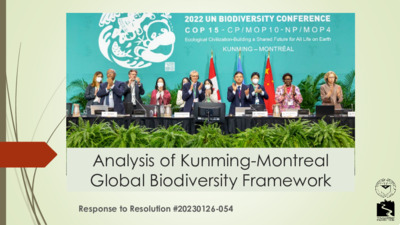20240821-005: Biodiversity Presentation — original pdf
Backup

Analysis of Kunming-Montreal Global Biodiversity Framework Response to Resolution #20230126-054 Kunming-Montreal Global Biodiversity Framework Resolution 20230126-054 Directs staff to analyze elements of the 23 Targets to align strategic direction Analyze elements of 23 Targets with goal of aligning relevant existing and SD28* proposed plans COP 15: 15th meeting of Council of Parties “The Kunming-Montreal Global Biodiversity Framework (GBF) was adopted during the fifteenth meeting of the Conference of the Parties (COP 15) following a four year consultation and negotiation process. This historic Framework, which supports the achievement of the Sustainable Development Goals and builds on the Convention’s previous Strategic Plans, sets out an ambitious pathway to reach the global vision of a world living in harmony with nature by 2050. Among the Framework’s key elements are 4 goals for 2050 and 23 targets for 2030.” Ref: https://www.cbd.int/gbf Biodiversity: What and Why Biodiversity: Variety of life in the natural world measured as number of different species that share a particular region • • • • • • Improves stability and resilience of an ecosystem • Maintains ecosystems web of codepedencies Provides more ecosystem services: • Water Filtration (wetlands, riparian buffers, mussels Flood attenuation (healthy soil biota, wetlands, tree canopy) Food security (pollinators, healthy soil biota, sustainable fisheries) • Medicines (new chemical compounds) Economic resiliency (ecotourism, climate resilience) Social importance (cultural/religious practices, intellectual/artistic pursuits, sense of place) https://www.nrdc.org/stories/biodiversity-101#whatis Types of Biodiversity • Genetic diversity within the population of a species Total number of species within a region/area/ecosystem • • Functional diversity – what niches are being filled in an ecosystem (Ex: foraging, nutrient cycling, predation) • Diversities of ecosystems (prairie, wetlands, riparian forest) https://www.nrdc.org/stories/biodiversity-101#whatis Threats to Biodiversity • Habitat loss • Climate change • Wildlife trafficking and trade • Pollution & toxic chemicals https://www.nrdc.org/stories/biodiversity-101#whatis Kunming-Montreal Global Biodiversity Framework (3) Themes and (23) Targets Reducing threats to biodiversity Tools and solutions for implementation and mainstreaming Meeting people’s needs through sustainable use and benefit-sharing City Council Resolution#20230126-054 Analyze elements of the Kunming-Montreal Global Biodiversity Framework’s 23 Targets with the goal of aligning existing and proposed plans with applicable elements of the targets. Memo to Mayor and Council previously provided https://services.austintexas.gov/edims/pio/d ocument.cfm?id=423415 Analysis of existing adopted CoA plans The resolution identified 5 plans to review and staff identified 9 additional plans Identified in resolution • Austin Climate Equity Plan • Rain to River Strategic Plan (currently being developed) • Austin Urban Forest Plan • Climate Resilience Action Plan for City Assets and Operations • Imagine Austin Additional plans identified by staff • USFW Habitat Conservation Plan • Invasive Species Management Plan • BCP Land Management Plan • WQPL Land Management Plan • Water Forward • Our Parks, Our Future • Watershed Protection Strategic Plan (this plan was used in place of the Rain to River Strategic Plan) • Urban Trails Plan • Austin/Travis County Community Wildfire Protection Plan Using AI to Meet Resolution's Ask Watershed Protection staff from the Geospatial Analysis and Data Analysis/Decision Support teams worked with the department’s Principal Planner to use Artificial Intelligence (AI) to evaluate plans for key words and phrases used in the biodiversity targets. The AI search was cross checked with a human centered QA/QC process to ensure an accurate interpretation of results. There were 299 total combinations of targets and plans searched. In the QA/QC of 30 randomly selected combinations, the search succeeded correctly 16 times, was partially correct 11 times, and was wrong 3 times. All Biodiversity Targets were referenced in at least one of the City plans evaluated. Note: UN Biodiversity Targets with the least correlation with existing City Plans either have elements that may be beyond the zone of control for City government or have a stronger focus on equity centered representation in decision-making than existing City plans have. Recommendations WPD and the Office of Sustainability will share the cross comparison of existing plans with the UN Biodiversity Targets with departments whose plans were studied, with the suggestion that as these plans are updated, they incorporate applicable biodiversity targets. The Equity Office should be invited to participate in plan update processes with a lens on racial equity and a focus on indigenous peoples, local communities, gender-responsive practices, persons with disabilities, and people in vulnerable situations. The Environmental Officer and Sustainability Officer will establish a cross-departmental biodiversity work group. City scientists should explore options like statistical modeling, remote sensing, and eDNA methods to develop a citywide biodiversity monitoring method. Special thanks to WPD’s Pioneering AI Team It took 8 team members 60 hours to do the search with the chat assistant and the QA/QC. A rough estimate for an individual to search the plans for the targets and enter the results is that it would take at least 150 hours The AI search was cross checked with a human centered QA/QC process to ensure an accurate interpretation of results. Technology Pioneers: Will Burdick, Andrew Chu, James Collins, Courtney Guidry, Harshita Mahaseth, Abel Porras, Iris Reyes, Danielle Warden Institutional Plans Knowledge: Jessica Wilson, Erin Wood QUESTIONS?